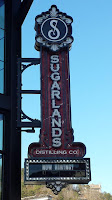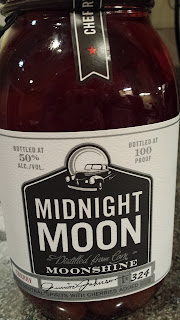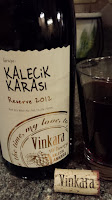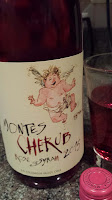
This year
Linganore Winecellars is celebrating it's 40th anniversary as the winery opened in 1976 after planting their first vines 1972. They relied on Cornell University to help determine which grape varieties to plant and eventually became a test vineyard for their experiential grapes. In 1978 the winery augmented their grape production with fruit wines after a local plum grower lost a verbal contract. Today Linganore is a giant among local wineries producing 155 thousand gallons annually. And they are proud of their upcoming 2016 offerings and organized an industry tasting of these wines in preparation for a similar consumer barrel tasting available this weekend. Mostly known for their festival style and fruit wines, Linganore also produces a wide range of dry and off-dry wines. These wines were the focus of our visit.

Second generation winemaker Anthony Aellen, Marketing Director Jessica Garcia, and a trio of young winemakers led our group on a tasting of several wines fermenting and aging for a future release. After a brief introduction about the history of the Aellen family and winery (available
here) we entered the tank room to sample the off-dry, Cayuga based
White Raven. In the past this wine was 100% Cayuga but this year they blended it with 18% Chardonnay which added much needed weight. At .5% R.S., this wine comes off completely dry. Later in the tasting room we sampled the current release which falls flat in comparison.
We then moved to the barrel room laden with rows of American, French, and even Bulgarian oak barrels. We started with the a sample of the base that will eventually become their méthode champenoise
Sparkling Cuvee. The
Vignoles grapes were harvested early in order to retain more acids and is currently aging in neutral oak. There is still an element of toastiness that blends with the grape's citrus flavors. I'm looking forward to seeing this base transition to a sparkling wine. We next tasted what will become their
Reserve Chardonnay. This wine will eventually see eight months in oak and we we tasted it half way through the process. It starts with a buttery aroma, but the oak influences fade as the Chardonnay flavors dominate to the finish. Linganore's winemakers are waiting for the oak to integrate in finish and then it's off to bottling. Again, later in the tasting room, we sampled the current
2014 Reserve Chardonnay and it was fantastic. Perhaps the best wine from Linganore that I had tasted - bright fruit, texture, just a little oak presence, and plenty of acids. We concluded our tasting of whites with a
Late Harvest Vignoles that is in it's second year in barrel. I was ready to take this home now, layers of creamy lemons unfolded throughout the palate. I wonder where this wine is headed?
Moving to reds, Linganore grows Chambourcin, Petit Verdot, Cabernet Franc, Cabernet Sauvignon, and even Barbera -- although they usually augment their Barbera with fruit from a grower near Westminster. In 2015 the winery was able to harvest the Chambourcin and Petit Verdot just before a two week rain deluge, but the Cabernet had to wait until after the storms. The Cab and Barbera were still undergoing malolatic fermentation, which all reds undertake in order to reduce their acid levels, so we sampled just the Chambourcin and Petit Verdot. Both of these were from three year old vines producing their first commercial harvest. And they were tasting well, particularly the PV which possessed loads of deep cherry flavors. They may bottle this as a single varietal wine or it may be used to augment the Cabernet in their
Red Skins wine. We were also able to sample three dry reds in the bottle which were just waiting on labels before release. Their
Bacioni (Italian for "A Big Kiss") is Barbara based and is a fruit forward friendly wine with easy tannins on the finish. And at $15, a great value. The
Estate Chambourcin is more complex but still easy on the palate. And the
Reserve Cabernet, a blend of Cabernet Franc and Cabernet Sauvignon, is tasting nicely as well. This is a creamy textured wine with more tannins and acids than the previous two. Nicely done again.

Our last endeavor was to sample their Port styled wines aging in barrel, all fortified with neutral grape spirits. We started with their
2015 Ruby Chambourcin that has been in barrel for only three months. It was big, but aggressive with acids taking over the profile. We then sampled the
2014 Ruby Chambourcin that was entering it's second year in barrel. The contrast showed the benefits of this extra year as the wine was rounder, the caramel flavors more prevalent, and it had a much more pleasant finish. Afterwards Anthony couldn't help himself and indulged us with a barrel tasting of their
Black Raspberry port styled wine. He's justly proud of this wine. First you don't find that many black raspberry wines, but also, this wine tastes exactly like the fruit. He and the other winemakers at Linganore are justly proud of their upcoming releases. There's no reason to wait until a music festival. Visit anytime.
 Moonshine isn't the only game in town in East Tennessee. Wine has gained traction west of the Smokies with over a dozen operating east of Knoxville. There's even The Rocky Top Wine Trail to guide you to five of these; although we still prefer the theCompass Winery, Brewery, Distillery Locator Mobile App. During a recent trip I was able to sample wine from three Tennessee wineries and yes, a majority of them are sweet. There's plenty of fruit wines, muscadine wines, hybrids, labrusca, and blends of all kinds. When vinifera did surface, the wine was usually made from left coast grapes -- although there was one wine that included locally grown Viognier. In general, the wines I sampled were well made and included several pleasant surprises.
Moonshine isn't the only game in town in East Tennessee. Wine has gained traction west of the Smokies with over a dozen operating east of Knoxville. There's even The Rocky Top Wine Trail to guide you to five of these; although we still prefer the theCompass Winery, Brewery, Distillery Locator Mobile App. During a recent trip I was able to sample wine from three Tennessee wineries and yes, a majority of them are sweet. There's plenty of fruit wines, muscadine wines, hybrids, labrusca, and blends of all kinds. When vinifera did surface, the wine was usually made from left coast grapes -- although there was one wine that included locally grown Viognier. In general, the wines I sampled were well made and included several pleasant surprises. Three wineries operate in the tourist mecca of Gatlinburg. We visited two starting with Tennessee Homemade Wines. As the name suggests, the family has been making homemade wines for over 100 years and the current batch consists of fruit, muscadine, and the world's most popular white labrusca grape Niagara. This wine wasn't bad, well made, just too much muskiness for my tastes. When in doubt, the Strawberry Stomp is excellent - comes across light and dry - and could pass for a dry rose. Well, maybe not completely - but close enough.
Three wineries operate in the tourist mecca of Gatlinburg. We visited two starting with Tennessee Homemade Wines. As the name suggests, the family has been making homemade wines for over 100 years and the current batch consists of fruit, muscadine, and the world's most popular white labrusca grape Niagara. This wine wasn't bad, well made, just too much muskiness for my tastes. When in doubt, the Strawberry Stomp is excellent - comes across light and dry - and could pass for a dry rose. Well, maybe not completely - but close enough. Sugarland Cellars was the second Gatlinburg winery on our agenda and provides a more traditional wine tasting experience with tours of the winery's operation. There's a plethora of unique choices from blended muscadine to fruit wines to sparkling Cayuga-Niagara - the Bliss. For fruit wines there's a sweet Cherry – Kee, but you have to try the Loganberry - a cross between a blackberry and a raspberry. And tasty. The Century White was my favorite - a blend of local Seyval and Viognier, blended with Washington state Riesling and more Viognier from California.
Sugarland Cellars was the second Gatlinburg winery on our agenda and provides a more traditional wine tasting experience with tours of the winery's operation. There's a plethora of unique choices from blended muscadine to fruit wines to sparkling Cayuga-Niagara - the Bliss. For fruit wines there's a sweet Cherry – Kee, but you have to try the Loganberry - a cross between a blackberry and a raspberry. And tasty. The Century White was my favorite - a blend of local Seyval and Viognier, blended with Washington state Riesling and more Viognier from California. 















































